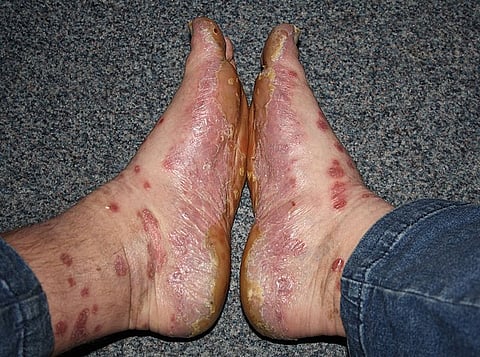

Very few patients with psoriasis are depicted in scientific articles – only a fraction of those included in the research are represented in images. This is revealed by a study from the University of Gothenburg, Sweden together with researchers from the University of Copenhagen, Denmark. The lack of images complicates communication with patients, according to the researchers.
For this systematic review article, the researchers counted images of patients in 152 different randomized scientific studies focusing on treatment outcomes for biological drugs in psoriasis, published over a period of twenty years (2001–2021). These studies encompassed a total of 62,871 patients.
The results are published in the Journal of Dermatological Treatment. Most of the studies (77 percent) did not contain any patient images at all. In total, the scientific manuscripts, along with all available supplementary material, featured a total of only 203 images depicting 60 patients. This yields an image sharing rate of just under one per thousand of all the patients included in the studies.
Sam Polesie, Associate Professor at Sahlgrenska Academy – the University of Gothenburg's faculty of medicine – led the study. Also a dermatologist at Sahlgrenska University Hospital, Polesie argues that sharing images is an exceptionally effective method to illustrate the impact of various treatments on patients, particularly for inflammatory skin diseases. Psoriasis, one of the most prevalent among them, has a lifetime prevalence of 2–3%.
"Patients often find it challenging to grasp the core messages of scientific manuscripts. The clinical results are most often described in something called PASI values, which is a composite score for redness, scaling, induration, and distribution on predefined body areas. If dermatology researchers were to include more clinical images in their manuscripts, this would improve patients’ understanding of the expected treatment effects,” says Sam Polesie.
Psoriasis is a chronic immune-mediated inflammatory systemic disease characterized by red and scaly plaques. The severity of the disease varies from mild to severe, with patients suffering moderate to severe symptoms being the primary candidate for advanced systemic therapies. Over the past twenty years, biological drugs have been introduced. Despite the significant decrease in the cost of several of these drugs due to patent expiration and the introduction of biosimilars, the societal impact remains substantial.
The researchers acknowledge that healthcare professionals, rather than patients, are principally the target audience for scientific publications. However, they emphasize that patients' right to shared decision-making has become increasingly important in today's healthcare landscape. Healthcare is undergoing a paradigm shift that underscores the need to bridge the gap between complex research and patients' understanding.
Sam Polesie again:
"We hope that this systematic review can serve as an invitation to the pharmaceutical industry and other sponsors, as well as journal editors and authors, to include more images in scientific publications. Including more clinical images with our original manuscripts could better support patient involvement." (MV/Newswise)
